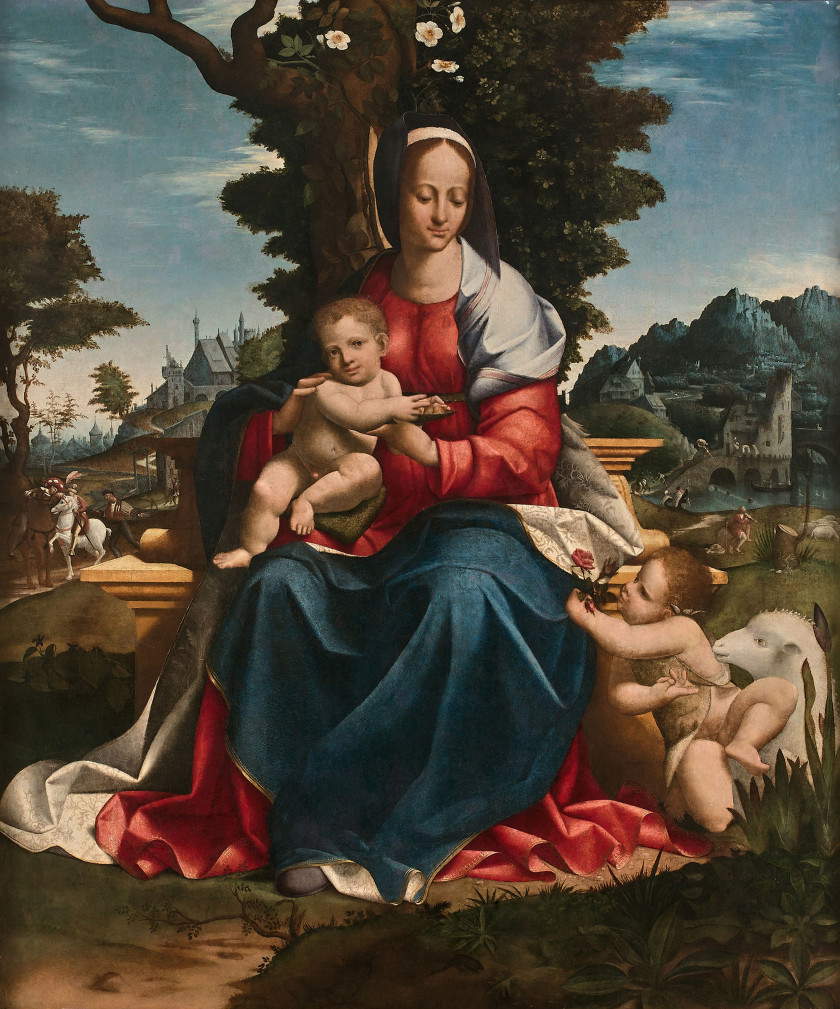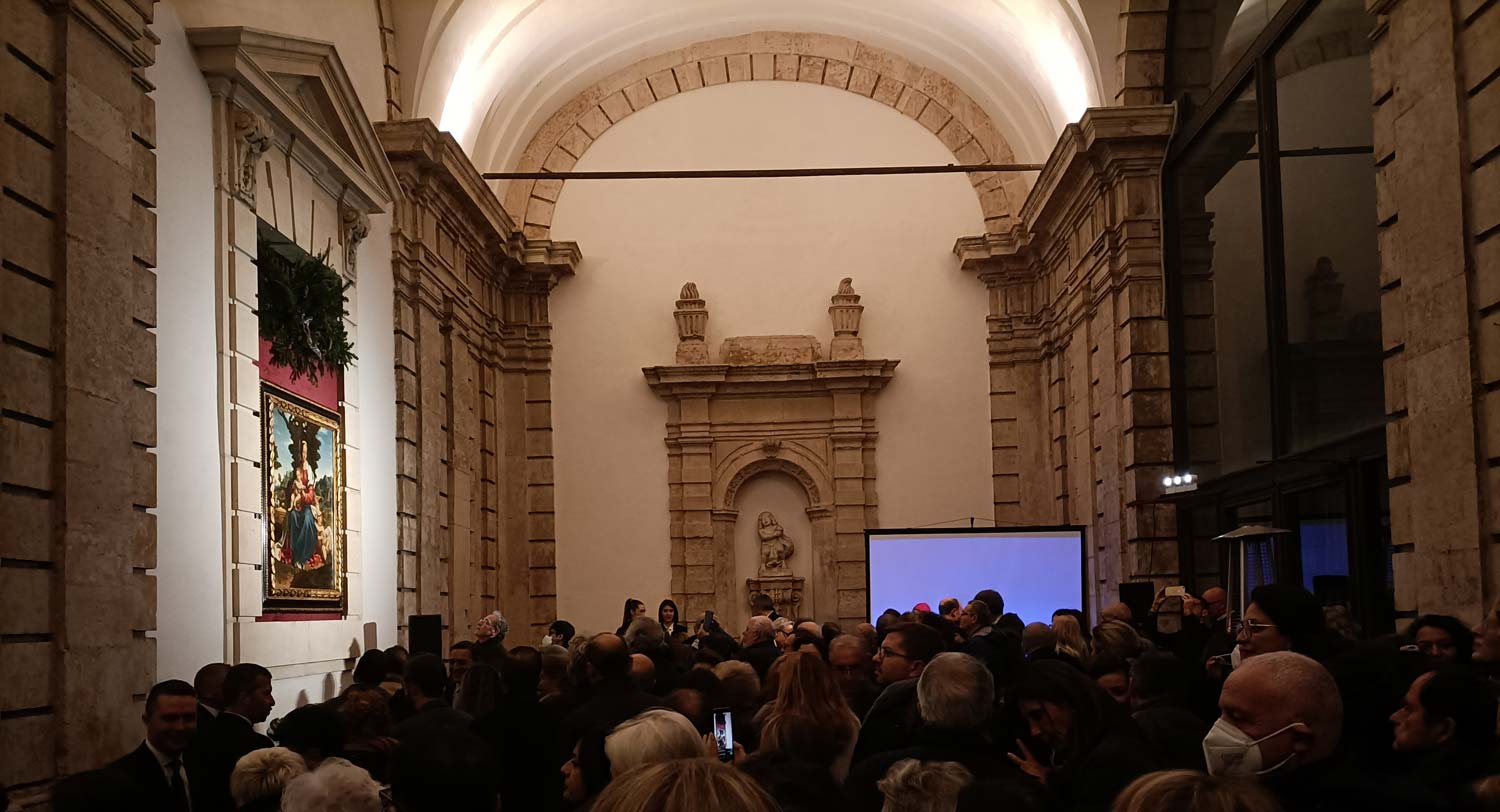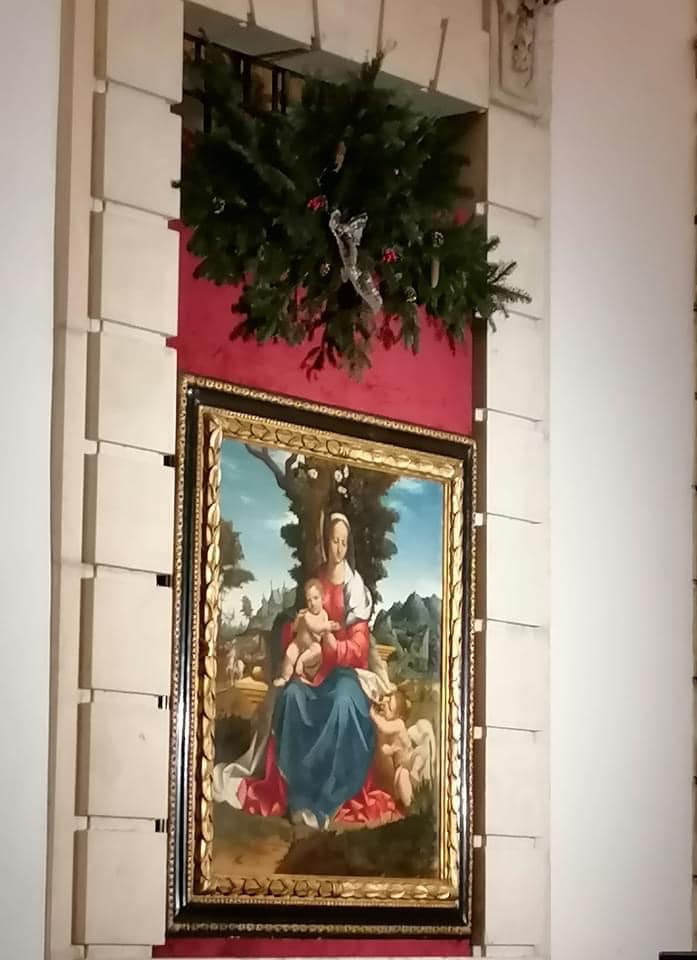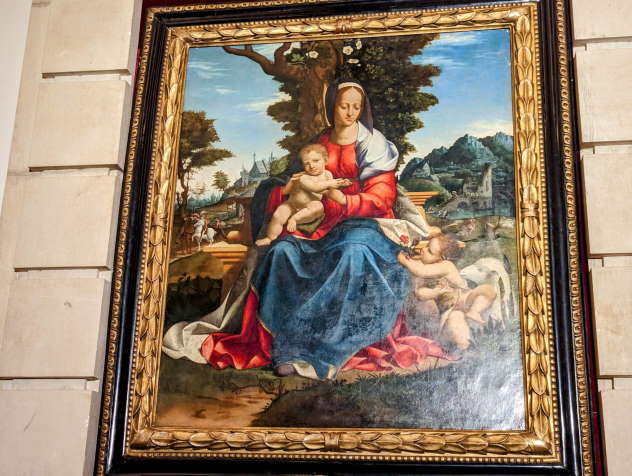Girolamo Alibrandi's Madonna in Messina: what's next?
What happens now? The curtain has come down in Messina after the day of celebration, the day of“revelation,” last December 12. In the etymological sense of “removing the veil,” of the red drape pulled down together with his mother Maria Grazia by an emotional Rocco Finocchiaro, the entrepreneur who won at the Artcurial auction the Madonna and Child with St. John, attributed to Girolamo Alibrandi. Figuratively speaking, for Christians, “revelation” is the moment when God manifests his will to mankind. At the Mount of Piety , the entrepreneur, surrounded by the affection of fellow citizens, said but did not reveal. Today is the last day of public display. “I’m keeping the work for now for myself,” he precisely said, “but I confess that when I visited the Museum and saw Alibrandi’s other paintings, I was moved and realized that the Museum could be its natural future destination.” Of course, the work is his and (for the time being) he can decide as he sees fit. But after igniting a city’s civic passion, it is then difficult to step into the shoes of the anonymous buyer, as those who win artworks at auctions usually remain. If, therefore, the sequel to the affair is yet to be written, for the recent past it has turned out that the initial goal was to allocate the painting to a former convent he purchased in Syracuse a couple of years ago. A proposal shelved precisely as a result of the unpredictable clamor aroused around the work starting with the impassioned reporting of the Messina-based art historian transplanted to Veneto Ranieri Melardi and the subsequent collection of signatures to the address of Cultural Assessor Elvira Amata for the Region to participate in the Paris auction.
For the time being, therefore, no agreement with the Region. Unable to participate in the auction due to tight timelines, Amata, freshly sworn into the Schifani junta, had necessarily had to move in extra time. Having approved the budget variation that would have allowed by a wide margin to win the work even at the price eventually beaten (133,824 euros, including taxes), she had said, in the days before the auction, she was ready to “sign a deed of obligation committing ourselves to reimburse all the expenses incurred by the private party to acquire the work.” Commitment then confirmed and relaunched once the name of the private buyer was learned.
To these stated intentions of the Region another piece was added. At the presentation of the painting, Orazio Micali, director of the MuMe, Interdisciplinary Museum of Messina, speaking on behalf of the department, explained that with the entrepreneur they had also discussed the “possibility of making thework available free of charge to the community , whether he wants to do it with a commodate or with a commodate preordained to the sale, whether he wants to do it in cession of the asset in favor of the public,” specifying also that these modalities had been discussed in the council and approved. In short, the region has done its part.

 The
The The presentation of the work at the Mount of Piety
The presentation of the work at the Mount of Piety The
TheAnd Messina itself, and its Regional Museum, is the Sicilian city that experienced the last major acquisition of a work of art to the regional heritage. That was in 2003. In that case, the Region moved in time and won at Christie’s auction in London the panel with the Madonna and Child Blessing and a Franciscan in adoration, on the recto, and Christ in Pity, on the verso. Critics (with the exception of Teresa Pugliatti) recognized its hand of Antonello da Messina. The work entered by right into Antonello’s catalog with the unforgettable monographic-event dedicated to the Master in Rome, at the Scuderie del Quirinale, in 2006, curated by Mauro Lucco. For a hit scored, however, we cannot say that the Region has ever pursued a real acquisitions policy.
What could be done, then, so as not to be found unprepared next time? Trivially, assign an official art historian (more delicate the question in the archaeological field, since the provenance of the auctioned artifacts is often doubtful) to follow up with the most important auction houses on a regular basis. Or make a structural intervention of political brand, such as endowing the main regional museums (Abatellis, Salinas and the Interdisciplinary Museum of Messina) with managerial and financial autonomy. The autonomous state institutes retain receipts from the management activity of the conferred assets, receive a base from the Ministry for personnel and structural interventions, and have their own budget. This makes it possible to speed up procedures related to accounting, expenditures, concessions, or even receipt of funds from private individuals. And to increase the collections with their own funds. The Museum of Messina in our case could have put in place a more streamlined procedure in autonomy from Palermo on the administrative level (other the finding of political appreciation of the operation, which in any case at this turn there was).
In the immediate term, however, the region is not just left with the role of window-watcher. Far from it, it is a key moment: that of protecting the work, regardless of ownership, through the Superintendency, which at the Mount of Piety has certified the work’s value and autograph. Superintendent Mariella Vinci made it clear that there was nothing the Region could do to act at least by way of pre-emption, since the work of art is not bound, and moreover it is outside the National territory, and therefore out of range of our protection regulations. Now, however, the formal act by which the Institute can recognize that value is to initiate ex officio for the painting the procedure of declaration of cultural interest under Article 13 of the Code. To our knowledge this has not yet been done, not since the day the painting set foot on regional soil, not since last Wednesday, when at least one art historian from the Soprintendenza was able to observe it de visu in a preview in Messina.
We would have liked to ask the Superintendent, but she prospected us with a long rigmarole (“request for authorization from the Department, inform the Assessor’s press office officer”). We are sure that efforts will be made to that end. But when? When will notice be given to the owner (Art. 14, headed “Declaration process,” c. 1), who will then have at least 30 days to submit any comments? Finocchiaro has already demonstrated all his attachment to his hometown to which he has returned precisely in 2020, the peak year of the covid pandemic, to take on such an entrepreneurial challenge as founding a new company, Zancle 757 Yacht Village. The point is another: it is that after the Administration has just noted its own impotence precisely because of the absence of constraint on the work, it was the first step we would have expected.
In fact, the notice alone entails the application, as a precautionary measure, of the protective provisions (Art. 14, c. 4). That is, it obliges the owner to apply to the preservation agency before taking any action, whether to move the work or subject it to restoration or sell it. Even just to move it to Monte Carlo, for example, where Finocchiaro resides and where the proceedings could no longer be initiated, if they had not already been done in Messina, because it is outside the national territory. After the lien is affixed, the work could also be sold, but at that point the Region could assert its right of first refusal. If the Region was powerless in Paris, such inaction would not be explained now. Legitimate doubts, since in none of the many communications from the Assessorate was there any mention of a declaration of interest procedure in place or even an announcement of it. Nor was this explicitly referred to by the Superintendent, who was also keen to point out that unfortunately the work was not listed in Paris.
In the city, however, there is already concern about something else. The spontaneous committee, among which several art historians appear, that had asked the region to purchase the painting has lost sight of its purpose, that of securing it for public enjoyment: “In emotional words, he said that he does not care about the work’s commercial value: he wants first and foremost to enjoy its beauty. Why pull Rocco Finocchiaro by the jacket? Why solicit hot statements from him?” Perhaps it is because, in addition to the four or five scholars who will perhaps enjoy exclusive access to the work, ordinary citizens have really dreamed of feeling this Madonna a bit themselves, thinking they can enjoy it in the halls of their city’s museum.
Warning: the translation into English of the original Italian article was created using automatic tools. We undertake to review all articles, but we do not guarantee the total absence of inaccuracies in the translation due to the program. You can find the original by clicking on the ITA button. If you find any mistake,please contact us.




























